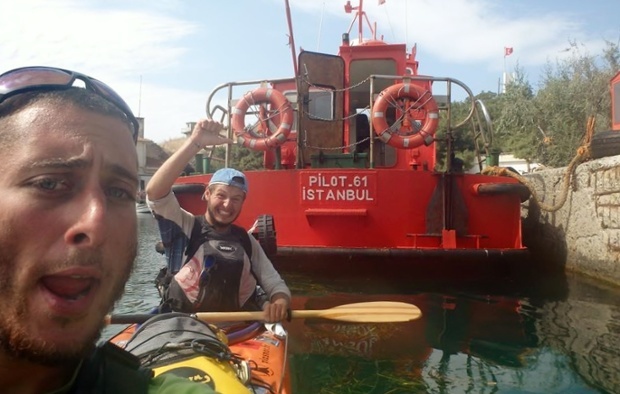Two French oceanography researchers expected to find pollution on their 8,345km, 14-month kayak journey from Gibraltar to Istanbul – but what shocked them was the endless spread of cities along the coast

On 11 October, two French oceanography students, their faces wind-beaten and sun-scorched, arrived in Istanbul after a 14-month journey from Gibraltar.
They didn’t come by car, train or bicycle; the 8,345km trip took place in a kayak, paddled stroke by stroke, metre by metre along the Mediterranean coast.
When they started out, Douglas Couet and Louis Wilmotte, both 23, knew they’d encounter pollution: the expedition’s aim was to undertake oceanographic research on noise, and to raise awareness of the Mediterranean’s important ecosphere. But in the main they expected a fairly serene paddle through quiet coastal scenery.
From our partners:
Instead, they were greeted by the endless spread of cities.
“We only had our eyes to witness pollution,” said Couet. “But we were very impressed by huge coastal urbanisation. Close to big cities, we saw a lot of plastic waste in the water. At some point we could actually realise we were getting close to a big city or to a national park, depending on the amount of plastic in the water.”
The north coast of the Mediterranean Sea has 11 cities. Istanbul is the biggest; Spain’s is the most populated, with half its 10 biggest cities on the water. In France, Italy and the Balkan states, the coast has become so urbanised that more than half the coastline is now paved. That rises to 70% along Italy’s Adriatic coast.

Take Benidorm, where in 1950 just 2,700 residents lived in a sleepy village. Local farmers harvested olives, lemons and oranges in fields that swept down to the rocky shore. Nearby hills lay bare in the stifling summer heat and year-round drought. But the village, founded almost 600 years ago, saw its income fall in the 1950s with the closure of its tuna market. Locals turned to tourism.
Today, Benidorm is one of the centres of the European package holiday world. Every year, 1.5 million British tourists alone head to the “Manhattan of the Med”, perhaps the most dramatic example of urbanisation anywhere along Europe’s Mediterranean coast. From 1,800 residents per square kilometre in the 1980s. Today, during the summer tourist season, that density can reach as high as 50,000 or more, with towers rising 50-plus storeys into the sky.
There’s no disputing the fact that tourism is critical for Europe’s Mediterranean countries: a whopping 30% of the world’s tourists come here to holiday, spending about €160bn (£125bn) in each of Spain and Italy alone.
But following the economic downturn, almost half a million houses in Spain now lie empty – and planning, as witnessed by the kayakers up close, is out of control.
“La Manga in Spain is an example of human nonsense: 20km of city length, two kilometres wide, with huge buildings all along,” said Couet. “What’s nonsense about it is that this place is used only two months in a year. They destroyed a unique lagoon with an interior sea to please people for two months.”

Greece’s postwar shift from agriculture to industry saw droves of people leave the interior for the coast in the 1950s and 1960s. More than a third of Greeks now live within two kilometres of the waves. In the 1970s, tourists came to Athens in increasing numbers – not for the history, as they had done before, but for the beaches and islands.
The centre of this change in Athens was the south-west Piraeus district. In the 1930s, Piraeus was a rudimentary harbour; it was bombed by German planes in the second world war. Today, it is the third-busiest passenger port on the planet. Every day, dozens of cruise ships and high-speed catamarans ferry the crush of tourists and revellers bound for the constellation of Greek islands in the east Mediterranean and Aegean seas.

For the French kayakers, who paddled their craft nine hours a day, the cold was a test –on two occasions their kayak capsized, once in the pitch-black sea between Rome and Naples, seven kilometres from the nearest harbour – but it was equally difficult to face their final destination. Approaching Istanbul, 435 days after slinking into the sea in Gibraltar, the pair found the city’s tendrils reaching down the Thracian coast. Istanbul now snakes 70km along the water, swallowing town after town.
“A lot of different feelings emerge from being such a long time with the water [from] a kayak’s perspective,” said Couet. “Going back to huge cities … we were a bit disconnected from this reality.”
It’s likely this disconnect will happen less often, as cities continue to spread here. Developments in Croatia and Albania, where until now the tentacles of humanity have been held back, are a major threat to some of the last major stretches of untouched coastline along the northern Mediterranean. There and elsewhere, the line of deck chairs will only grow.
This feature originally appeared in The Guardian.















